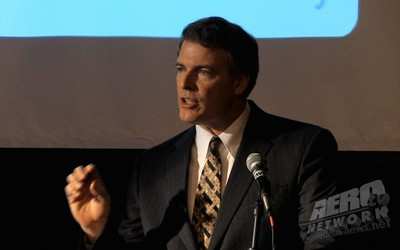Gama CEO Draws Attention To Aviation Safety, Modernization
Efforts
In testimony Wednesday before the House Aviation Subcommittee,
Pete Bunce, president and CEO of GAMA, emphasized the importance of
passing a multi-year FAA reauthorization bill in 2011. In his
opening remarks, Bunce emphasized the important role general
aviation plays in the U.S. economy. The industry contributes
over $150 billion to the economy each year and supports more than
1.2 million high-paying, technical jobs.

Pete Bunce Appearing On Aero-TV
He also testified that GAMA member
companies have suffered more than 20,000 layoffs over the past two
years and deliveries of general aviation airplanes have declined
sharply as a result of the economic downturn. "Despite these
tremendous economic challenges, our member companies have responded
by continuing to invest in innovative products and technologies
that will allow them to take advantage of new market opportunities
as the recession ends," said Bunce.
Bunce also emphasized that Congress must provide sufficient funding
and direction to advance NextGen. In addition, he said, GAMA
believes that the subcommittee must find ways to incentivize
operators to equip their aircraft earlier than the current federal
mandate. "The aviation industry stands ready to work with you in a
public-private partnership to accelerate NextGen through aircraft
equipage so that we can begin to accrue the environmental,
efficiency, and safety benefits of NextGen as soon as possible," he
said.
Bunce urged the to subcommittee that, in order to ensure that the
work performed at repair stations remain safe, the FAA should be
required to implement a risk-based system that provides the
discretion to inspect repair stations based on the complexity and
amount of work performed on U.S.-registered aircraft. Bunce also
urged the committee to strongly support the U.S.-E.U. aviation
safety agreement which will only enhance safety oversight
capabilities. "To improve aviation safety and use resources
efficiently, we strongly urge the committee to include a risk-based
provision in this bill that helps the FAA meet its mission while at
the same time protects international agreements."

As GAMA members continue to invest
heavily in new products and technologies, Bunce focused the last
portion of his remarks on the importance of adequate certification
resources necessary to deliver new products to market, support
NextGen technology and help the piston aircraft industry transition
to unleaded aviation gas. Despite the best efforts of the
FAA, many manufacturers are subjected to a sequencing process which
can cause delays and threaten their manufacturing
competitiveness. Bunce concluded with a call for the
formation of an advisory committee consisting of industry
stakeholders to make recommendations on streamlining the
certification process. He said, "The FAA will always need
sufficient certification resources, but we can hopefully find
savings through improved processes. If we don't take this
path, our ability to create and protect jobs in this country will
be severely impaired."
During questioning from Members of both parties, Bunce warned
the committee that without environmental streamlining of the
airspace redesign process, it will be very difficult, if not
impossible, to accelerate NextGen. "In order for aircraft to
fly more efficiently in the system, we need to change the path they
fly today," he said. "Currently, this is a very time
consuming process and the FAA must be able to make environmental
reviews that expedite new procedures in order to make flying more
efficient, thereby providing environmental benefits."
 Classic Aero-TV: In Praise of Alabamas Patriot Aircraft USA
Classic Aero-TV: In Praise of Alabamas Patriot Aircraft USA NTSB Final Report: Cirrus Design Corp SR22
NTSB Final Report: Cirrus Design Corp SR22 ANN's Daily Aero-Term (12.21.25): Dead Reckoning
ANN's Daily Aero-Term (12.21.25): Dead Reckoning ANN's Daily Aero-Linx (12.21.25)
ANN's Daily Aero-Linx (12.21.25) Aero-News: Quote of the Day (12.21.25)
Aero-News: Quote of the Day (12.21.25)




